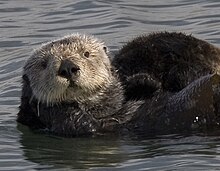

…………………………………………………………………………………….
Monday, December 14, 2015 by: L.J. Devon, Staff Writer

(NaturalNews) The Marine Mammal Center rescued over a hundred sea lions in a 10-day period off the West Coast of California in the winter of 2015. The influx of stranded sea lions is a sign that the health of the ocean is deteriorating. From January 1 to February 12, 2015, National Geographic counted nearly 500 rescued sea lions, an amount that is alarming scientists. Something has gone awry in the West Coast waters.
The sea lions are not finding food, they are losing strength, and many are starting to wash ashore. The startling trend didn’t start in 2015. The number of stranded sea lions began rising in the winter of 2013, when scientists started noticing waves of sea lion pups washing ashore. Scientists believe the ocean’s temperatures have shifted. Warmer currents may be affecting food sources that the sea lions depend on. Others see problems in ocean water acidity. The animals are being forced to go on longer quests to find food. Many of the pups are being left behind, stranded, while their parents search for food.
One-third of sea lions born last summer wiped out
The death of this sentinel species is an indication of changes in ocean climate and ecosystem. Sea lion prey, which include sardines and crayfish, are reportedly disappearing in numbers as well, forcing the starving sea lions to go on longer quests in search of food. Scientists are concerned about ocean pH and rising acidity of the waters. According to San Jose Mercury News, marine biologists warn that, if the trend continues, an entire generation of California sea lions could be wiped out.
When speaking to NBC News, Sea World San Diego senior veterinarian Hendrick Nollens reported, “We had rescued 19 California sea lions in January [2013]. This year we already rescued 87 pups in that same month. So this event seems to be much larger.”
According to the Daily Breeze, the “unusual mortality event” wiped out two-thirds of the sea lion pup population off the West Coast in 2013.
Rehabilitation centers are taking several hundred pups in this year to save the species from total extinction.
NOAA wildlife biologist Sharon Melin confirmed that most pups captured in the wild in 2013 were only half their weight. After they are released back into the wild, they are expected to maintain their weight. When Melin went on a research trip in September 2013, she reported that the weight of the pups was still low. She brought back the bad news: “We’ve told the centers to prepare for the worst.”
The U-T San Diego concurred, reporting that pups in the Channel Island rookeries continued to struggle despite rehabilitation efforts. On average, pups were 19% below their average weight, even after rehabilitation.
Jim Milbury of NOAA Fisheries says that West Coast sea lions have a birth rate of about 50,000 a year, and San Diego 6 reported on Jan. 28, 2015, that nearly 1 of 3 pups born the previous summer have already died.
If 33% of pups born in 2014 have already died, then based on the average birth rate, over 15,000 have passed away in that short time frame.
Ocean water acidity on the rise, subjecting aquatic life to disease
According to Jennifer Palma of Global News, ocean health is deteriorating, indicated by a die off of scallops and oysters. “Getting pacific oysters and scallops is next to impossible; the industry is in crisis. … So what’s killing the Pacific oysters and scallops? A possible combination of factors including warmer oceans, decreasing acidity levels and potentially disease,” she said in a report.
University of British Columbia marine microbiology professor Curtis Suttle is concerned about changes in the pH of ocean waters. “The hypothesis — there’s a working hypothesis –w is that these changes, these excursions in pH, are making the shellfish vulnerable to infection by diseases that they would normally be resistant to.”
Sources for this article include:
http://enenews.com
http://enenews.com
http://enenews.com
http://www.dailybreeze.com
…………………………………………………………………………………….
The NaturalNews Network is a non-profit collection of public education websites covering topics that empower individuals to make positive changes in their health, environmental sensitivity, consumer choices and informed skepticism. The NaturalNews Network is owned and operated by Truth Publishing International, Ltd., a Taiwan corporation. It is not recognized as a 501(c)3 non-profit in the United States, but it operates without a profit incentive, and its key writer, Mike Adams, receives absolutely no payment for his time, articles or books other than reimbursement for items purchased in order to conduct product reviews.
The vast majority of our content is freely given away at no charge. We offer thousands of articles and dozens of downloadable reports and guides (like the Honest Food Guide) that are designed to educate and empower individuals, families and communities so that they may experience improved health, awareness and life fulfillment.
Learn More About Natural News Here//

 Fish were the first organisms to wash ashore dead after the algal bloom was announced. (Image Source: Missy Dubuisson)
Fish were the first organisms to wash ashore dead after the algal bloom was announced. (Image Source: Missy Dubuisson) Dead seagull found lying on beach in Pass Christian. (Image Source: Missy Dubuisson)
Dead seagull found lying on beach in Pass Christian. (Image Source: Missy Dubuisson)



















